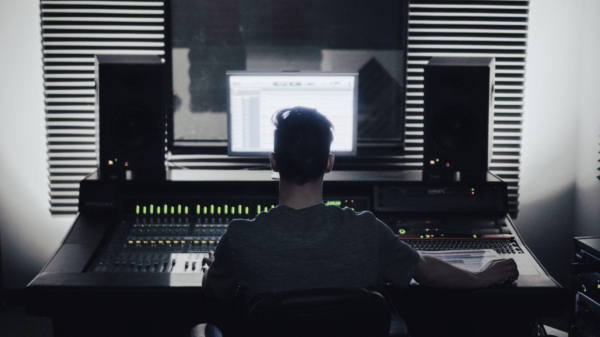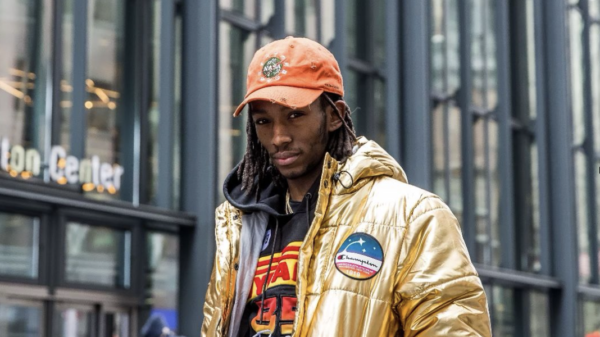In his debut book, Uncharted Territory: What Numbers Tell Us About the Biggest Hit Songs and Ourselves, author Chris Dalla Riva offers a data-driven exploration of the trends that have shaped pop music. Dalla Riva lives at the intersection of these two worlds as a musician, the author of the popular newsletter Can’t Get Much Higher, and a senior product manager at the streaming platform Audiomack.
In the book’s intro, Dalla Riva explains how the book originated after he stumbled upon a Spotify playlist claiming to boast every song that had hit Number One on the Billboard Hot 100. He started jumping around and collecting random data points: The shortest Number One hit was Maurice Williams and the Zodiacs’ 96-second song “Stay”; there have been 12 Number One hits by artists name Bob, a list that includes B.o.B, but not Bob Dylan. Eventually, Dalla Riva decided to listen to every chart-topper in chronological order while building “a dataset that tracked a variety of facts and figures about the songs in hopes of writing about my journey.”
The result, Uncharted Territory — out today — was written “through musical, historical, and analytical lenses, using data to tell the story of American popular music.” It’s a book that spans nearly 70 years, starting Aug. 4, 1958, when Ricky Nelson’s “Poor Little Fool” became the first Number One, and ending on Jan. 11 when Lady Gaga and Bruno Mars topped the Hot 100 with “Die With a Smile.”
The chapter excerpted below, “It’s a Damn Good Thing We Danced the Macarena,” covers July 8, 1989 through August. 3, 1996, and focuses primarily on P.M. Dawn’s “Set Adrift on Memory Bliss.” The song was the first Number One of the SoundScan era, when Billboard implemented a new accounting system that relied on point-of-sales data as opposed to sometimes-unreliable surveys from record sellers. As Dalla Riva explains, the introduction of SoundScan, and the success of “Set Adrift on Memory Bliss,” completely reconfigured our understanding of what was actually popular in music.
Editor’s picks
And I Wonder If Tomorrow Will Be Like Yesterday
When P.M. Dawn’s “Set Adrift on Memory Bliss” got to the top of the charts in November 1991, they were plumbing the depths of the past. The song, a nostalgia-soaked haze referencing the work of many earlier artists, captures the aching memory of a failed relationship.
Though P.M. Dawn was a hip-hop act, their musical creations stood apart from their contemporaries. To generalize, much of hip-hop at the time was either lighthearted party music — like MC Hammer’s “U Can’t Touch This” — or vivid, sometimes violent, socio-political commentary, like Public Enemy’s “Fight the Power.” P.M. Dawn was neither of those things. Their music was contemplative and ethereal, often harkening back back to the psychedelic sounds of the 1960s. People magazine described their debut album as “something new, hip-hop that ignored the streets and aimed for the heavens.”
Prince Be and DJ Minutemix, the two members of the group, shopped around a demo in the late 1980s but struggled to land a record deal. The independent label Warlock eventually released their debut “Ode to a Forgetful Mind” in 1989, but it failed to make an impact. Warlock soon licensed the record to the British hip-hop label Gee Street. After being purchased by Island Records, Gee Street would release the duo’s debut album Of the Heart, of the Soul, and of the Cross: the Utopian Experience in August 1991. The romantically titled disc would go on to receive near-universal praise from critics.
Despite being deeply entrenched in the past, P.M. Dawn’s music was symbolic of the future. Part of that symbolism was how it got to number one: “Set Adrift on Memory Bliss” was the first number one under SoundScan, Billboard’s new accounting system. But the other part was tied to what the song was: a hip-hop song by a Black duo. Though both statements feel humdrum, they were harbingers of seismic shifts in American popular music.
Related Content
Let Me Reassure You That You Can Count On Me
Imagine you own a record store. It’s late 1989, and Bad English’s “When I See You Smile” has been at number one for two weeks. You get a call from Billboard, and they ask what’s been selling at your store. This isn’t surprising. They call every week. It’s how they compile the Hot 100. You’re about to tell them that “When I See You Smile” remained the best-selling single. But you hesitate. You notice you have tons of copies of Milli Vanilli’s newest record, “Blame It on the Rain.” It hasn’t been selling as well as you were expecting. So, you decide to lie.
You tell Billboard that the European duo’s tune is flying off the shelves. They thank you, and then you hang up the phone. You feel guilty, but your hope is that if you can inflate the sales of “Blame It On the Rain,” then more people will buy it. Many of your customers shop that way. They dig through your display at the front of the store with Billboard’s most popular records when deciding what to purchase. Your shady behavior wasn’t going to last, though.
In late 1991, Billboard started aggregating the Hot 100 via SoundScan rather than surveys. “Set Adrift on Memory Bliss” was the first song to get to number one under this new system. Derek Thompson described this change in his piece in The Atlantic titled “1991: The Most Important Year in Pop-Music History”:
“So, for many years, Billboard wasn’t a perfect mirror of American tastes. It was warped by label preferences and record-store inventories … But in 1991, this changed. First, Nielsen ended the record-store charade by releasing SoundScan, which used point-of-sales data from cash registers in stores. Finally, Nielsen had timely information on which albums were really selling.”
When this change went into effect, it was clear that the old system had biases that benefited certain genres and artists. Paula Abdul proves a good example of this. The cheerleader-turned-pop-star had her final number ones in this era: “Cold Hearted,” “Opposites Attract,” “Rush Rush,” and “The Promise of a New Day.” Each song summited the charts pre-SoundScan. None of her six singles released in the SoundScan era even cracked the top 10.
“Sure,” you might contest, “but Abdul’s creative output slowed to a near halt after 1991. Maybe she wasn’t putting as much time into her music career.” I’d agree that was part of it, but “The Promise of a New Day” provides additional evidence of the benefits she was reaping in the pre-SoundScan era. When “The Promise of a New Day” topped the Hot 100, it wasn’t at the top of Billboard’s sales or radio play charts, both of which had already switched to SoundScan. Thus, the future American Idol judge achieved the impossibility of having the most popular record in the country without having the most popular song on radio or in stores.
This isn’t to say that Paula Abdul was unpopular. The human-reported, pre-SoundScan system just overstated that popularity. But beyond this specific example, there were more general changes that came about because of this improved data. One of the main things SoundScan taught us was that if pop songs were drugs, we’d all be hopelessly addicted.
I Really, Really, Really Love This Song
In 1960, Percy Faith sent his sprightly instrumental “Theme from A Summer Place” to number one for nine weeks, a new record. Beyond the Beatles matching that feat eight years later with “Hey Jude,” this nine-week mark proved quite formidable. In fact, by the time Debby Boone’s “You Light Up My Life” pushed the record to 10 weeks in the late 1970s, Percy Faith had been dead for a year-and-a-half.
This record also proved durable. Then Billboard switched to SoundScan, and everything changed. From 1960 to 1990, the record for weeks at number one only inched from nine weeks to 10 weeks. After SoundScan was introduced in 1991, the record was re-established three times in four years, eventually settling at 16 weeks with “One Sweet Day,” a duet by Mariah Carey and Boyz II Men. SoundScan, in effect, proved that our tastes were much stickier than the older, self-reported tracking system suggested.
This goes beyond number ones, though. In the figure below, you can see the average percent of new entries in the top 40 and top ten over 52 weeks. Before SoundScan, the top 40 averaged four to nine new songs each week. Immediately after SoundScan, the average was often between one and three.

Chart by Caileigh Nerney
In short, when we like a song, we really like it. We want to keep hearing it until it drives us crazy. And then we’ll listen a few more times. Take Los del Río’s “Macarena” as an example. If you’ve heard it once, you’ve heard it a thousand times. Yet it stayed at number one for 14 weeks and was so pervasive that politicians danced to it at the 1996 Democratic National Convention. The unexpected political dance was symbolic of SoundScan revealing humanity’s untreatable pop song dependence.
Take Heed ’Cause I’m a Lyrical Poet
If I stopped here, you would think that the intrigue around “Set Adrift on Memory Bliss” was only based on the fact that it was the first SoundScan number one. Whatever song happened to be number one when Billboard made the switch would have worn that historic crown. But, as I mentioned, its importance goes beyond historical happenstance because it was a hip-hop song by a Black duo. Let’s explore both parts of that statement to understand how they relate to the most dramatic shift in lyricism since the 1960s.
A Hip-Hop Song . . .
Earlier, we noted that before SoundScan, the Hot 100 was “warped by label preferences and record-store inventories.” In the same way that Paula Abdul benefited from those preferences, the entire genre of hip-hop was hurt by them.
Hip-hop wasn’t new in the 1990s. It had been growing in popularity for over a decade, and artists like Run-DMC had already scored hits working within the genre. But SoundScan made it clear that hip-hop’s popularity was clearly being masked. Here’s one way to see that. Five of the 50 number ones (10 percent) before SoundScan contained at least one rapped verse. Among the 50 after SoundScan’s introduction, 11 (22 percent) did, or more than double.
“Singers can hide their words . . . beneath a tune,” critic Kelefa Sanneh wrote in his book Major Labels. “But rappers are more exposed than singers, because their form of expression is more similar to speech. And so rappers spend lots of time explaining who they are, what they’re doing, and why they deserve your attention.” This similarity to speech and, according to Sanneh, necessity to “say your name, make a claim, [and] emphasize the backbeat,” led artists to pack more syllables in their songs.
As you can see in the figure below, before P.M. Dawn kicked off the SoundScan era with their 136-word-per-minute chart-topper, number ones averaged around 67 words per minute. From “Set Adrift on Memory Bliss” through the end of this era, that average rose to 89. In fact, the top five songs measured by words per minute all occurred in this era.

Chart by Caileigh Nerney
. . . By a Black Duo
Billboard wasn’t just undercounting hip-hop before implementing SoundScan, though. They were also undercounting songs by Black artists, like P.M. Dawn. This wasn’t a big secret. In Gerald Posner’s history of Motown, he recounts Marvin Gaye seething because “black artists like him . . . were at a disadvantage when it came to the pop chart since the people who compiled it [Billboard] tended to call only the large white record stores.” The data seen below bears out this claim.

Chart by Caileigh Nerney
Pre-SoundScan, 31 percent of number one songs were by Black artists or groups with at least one Black member. From the switch through the end of this era, 72 percent were. And this fact is independent of the rise of hip-hop. Among the first 50 non-hip-hop number ones in the SoundScan era, 76 percent were by Black artists.
The last time we talked about how songwriters were addressing new lyrical topics was Chapter 3. That’s when artists were reacting to cultural and political events of the 1960s. While musicians continued to react to external events in this era, the change in lyrical topics was driven by the fact that people from different ethnic backgrounds were getting to the top of the charts.
- On “Gangsta’s Paradise,” Coolio captures the needless violence of his environment.
- Both “Waterfalls” by TLC and “Tha Crossroads” by Bone Thugs-N-Harmony address addiction, death, and the plight of those suffering from HIV/AIDS.
- Though Kriss Kross’s “Jump” and Montell Jordan’s “This is How We Do It” come across as straightforward party starters, they are also both laced with a boastful swagger that was a staple in the hip-hop world.
We occasionally saw lyrical uniqueness from artists of other races in this era too. For example, Phil Collins preached about homelessness on “Another Day in Paradise,” Martika captured addiction on her droning “Toy Soldiers,” and Lisa Loeb brought a stream-of-consciousness approach to “Stay (I Missed You).” Still, the lyrical changes were largely driven by Black artists.
The Fate of P.M. Dawn
Given how much of this chapter is framed around P.M. Dawn, you might think that they were one of the most important hip-hop acts of all time. Though they presage some of the more melodic rap that we’ll talk about in Chapter 12, I’d be lying if I said they were. For that matter, other than charting two top ten singles off their sophomore album, they were barely part of the future that their number one symbolized.
Part of their demise was based on perception. In their early years, P.M. Dawn was heaped with praise by white critics and largely ignored by Black critics. In the same review quoted at the beginning of this chapter, People wrote, “Embraced by the mainly white rock press as the second (non-threatening) coming of rap, the two Cordes brothers of Jersey City, NJ, were, not surprisingly, reviled by rappers for the sin of being soft.”
Trending Stories
But it wasn’t just their perceived softness that put them at odds with the hip-hop community. It was their ideals. Prince Be opposed affirmative action (i.e., “It’s too focused on race. It lets people who aren’t qualified get jobs over people who are.”), downplayed the continued effects of slavery (i.e., “Slavery was hundreds of years ago. It’s time to forgive and forget.”), and levied criticism at some of hip-hop’s stars (i.e., “Public Enemy and people like that — they just make mountains out of molehills. KRS-One wants to be a teacher, but a teacher of what? N.W.A just don’t do anything at all”).The duo was also plagued by more existential issues. DJ Minutemix was charged with sexually assaulting an underaged cousin in 1995 a couple of weeks before the pair’s third album dropped. As those legal troubles mounted, Prince Be was battling diabetes, which resulted in multiple health setbacks. He would die from renal failure in 2016. His New York Times obituary described the group he fronted succinctly: popular, maligned, underappreciated, and quietly influential.
© Bloomsbury Academic, 2025. From Uncharted Territory: What Numbers Tell Us about the Biggest Hit Songs and Ourselves by Chris Dalla Riva published by Bloomsbury Academic on November 13, 2025 at $34.00.



























